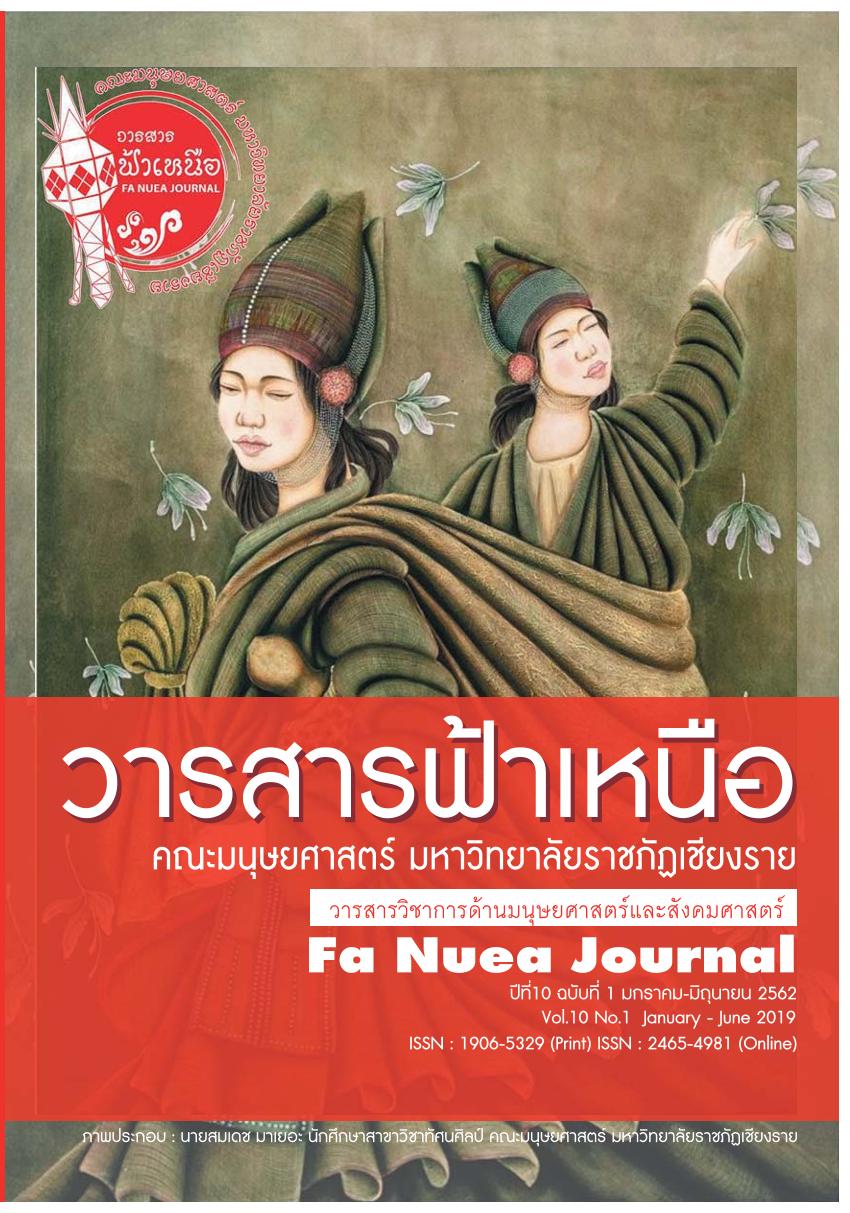LEARNING SUFFICIENCY THINKING THROUGH LOCAL FOLKTALES USING BILINGUAL READING AND DRAMA STRATEGIES FOR LOWER-SECONDARY SCHOOLS IN CHIANG RAI PROVINCE
Main Article Content
Abstract
This study applies sufficiency economic philosophy (SEP) thinking with two Chiang Rai local folktales for developing a teaching model for lower secondary schools in Chiang Rai Province. The three objectives include, 1) developing appropriate lesson plan model for teaching bilingual (Thai and English) reading and drama using two local folktales, 2) measuring sufficiency thinking competence through reading and drama using two local folktales and 3) measuring teacher/student satisfaction of developed learning material and strategies. The local indigenous content includes the research results of Asst. Prof. Chamroen Thanandorn, Legend of Nong Luang and the research of Mr. Albert Lisec, Legend of Buffalo Horn Hill. The research population involves the 70 M-2 lower secondary school students and 6 teachers from two Chiang Rai secondary schools. Data is analyzed using achievement percentage scores for SEP critical thinking competence with 80% benchmark for passing and for analyzing content/activities satisfaction, 70 students and 6 teachers answered questionnaire using Likert 5 means score. The results show that the teachers and students were satisfied the most with materials and learning activities as a whole at =4.77. 65 students out of 70 got full achievement test score which equals to 92.86 percent. In light of these findings, the research gave strong justification for supplementing and improving classroom curriculum by using local folktales in conjunction with communicative reading activities, bilingual approaches, dramatization, and SEP critical thinking exercises. Therefore, the findings of this research should prove useful for secondary school administrators, teachers and students.
Article Details

This work is licensed under a Creative Commons Attribution-NonCommercial-NoDerivatives 4.0 International License.
Articles, information, content, pictures, etc. which have been published in Fa Nuea Journal, are copyright of Fa Nuea Journal. If any person or party wishes to disseminate all or part of it or take any action must be referenced. Do not use for commercial purposes and do not modify (CC-BY-NC-ND). For further details, please access at Attribution-NonCommercial-NoDerivatives 4.0 International (CC BY-NC-ND 4.0)
References
กระทรวงศึกษาธิการ. (2551). หลักสูตรแกนกลางการศึกษาขั้นพื้นฐานพุทธศักราช 2551. กรุงเทพฯ: โรงพิมพ์สหกรณ์การเกษตรแห่งประเทศไทยจำกัด.
กิ่งแก้ว อัตถากร. (2514). การสอนโดยใช้นิทาน. พิมพ์ครั้งที่ 2. กรุงเทพฯ: ไทยวัฒนาพานิช.
ขวัญชนก นัยจรัญ. (2557). การวิเคราะห์ภาพสะท้อนค่านิยมของไทยจากนิทานพื้นบ้าน. มหาวิทยาลัยเทคโนโลยีราชมงคลสุวรรณภูมิ.พระนครศรีอยุธยา.
คณะอนุกรรมการขับเคลื่อนเศรษฐกิจพอเพียง. (2551). การประยุกต์ใช้หลักเศรษฐกิจพอเพียง.กรุงเทพฯ: สำนักงานคณะกรรมการพัฒนาการเศรษฐกิจและสังคมแห่งชาติ.
บุญชม ศรีสะอาด. (2545). การวิจัยเบื้องต้น. พิมพ์ครั้งที่ 6. กรุงเทพฯ: สุวีริยาสาส์น.
ปภาดา ชัยวัฒนโชติ. (2557). รายงานผลการใช้เอกสารประกอบการเรียน ชุดเศรษฐกิจพอเพียงและ เศรษฐกิจของประเทศไทย สำหรับนักเรียนชั้นมัธยมศึกษาปีที่ 1 โรงเรียนกบินทร์วิทยา อำเภอกบินทร์บุรี.สำนักงานเขตพื้นที่การศึกษามัธยมศึกษา เขต 7. กรุงเทพฯ.
ปิยะพร ศิลาอ่อน. (2553). ผลของการใช้นิทานพื้นบ้านต่อเหตุผลเชิงจริยธรรมด้านความซื่อสัตย์ สุจริตสำหรับนักเรียนชั้นประถมศึกษาปีที่ 1.ปริญญานิพนธ์การศึกษา มหาบัณฑิต มหาวิทยาลัยราชภัฏเทพสตรี.
พิชิต ฤทธิ์จรูญ. (2545). หลักการวัดและประเมินผลการศึกษา. กรุงเทพฯ:เฮ้าส์ ออฟ เคอร์มีสท์.
ล้วน สายยศและอังคณา สายยศ. (2545). เทคนิคการวิจัยทางการศึกษา. พิมพ์ครั้งที่ 5.
สรพงษ์ นกแสง. (2557). ปรัชญาเศรษฐกิจพอเพียงในนวนิยายของ CharlesDickens เรื่อง Christmas Carol และ เรื่อง Island of the Blue Dolphins ของ Scott O’Dell’s. วิทยานิพนธ์ปริญญาศิลปศาสตรมหาบัณฑิต สาขาวิชาภาษาอังกฤษ มหาวิทยาลัยศรีนครินทรวิโรฒ.
Atkinson, D. (1987). The Mother Tongue in the Classroom: A Neglected Resource. ELT Journal, 41/4: 241-247.
Banker, C. (2001). Foundation of Bilingual Education and Bilingualism.Great Britain: Biddles Ltd.
Eric K. Taylor. (2000). Using Folktales. Cambridge University Press.
Harbord, J. (1992). The Use of the Mother Tongue in the Classroom. ELT Journal, 46/4: 30-55.
Kavaliauskiené, Galina. (2009). Role of Mother Tongue in Learning English for Specific Purposes. ESP World, Issue 1 (22), Volume 8, (Online) Available http: http://www.esp- world.info.
Zongrang, Zhang. (2010). A Research on the Gain and Cost of Bilingual teaching of Non-English- Oriented Course. (Online). Shandong: Shandong Institute of Business and Technology.
ทฤษฎีการเรียนรูข้ องกาเย (Gagne’s Instructional Model). (ออนไลน) แหลง่ ที่มา: https://uthailand.wordpress.com/2011/08/17/gagne/ เข้าถึงเมื่อวันที่ 17 พฤษภาคม 2560.
หลักการสอนโดยโรเบิร์ต กานย่. (2550). (ออนไลน์) แหล่งที่มาhttp://www.kroobannok.com/92.12 เข้าถึงเมื่อวันที่ 11 สิงหาคม 2559.


